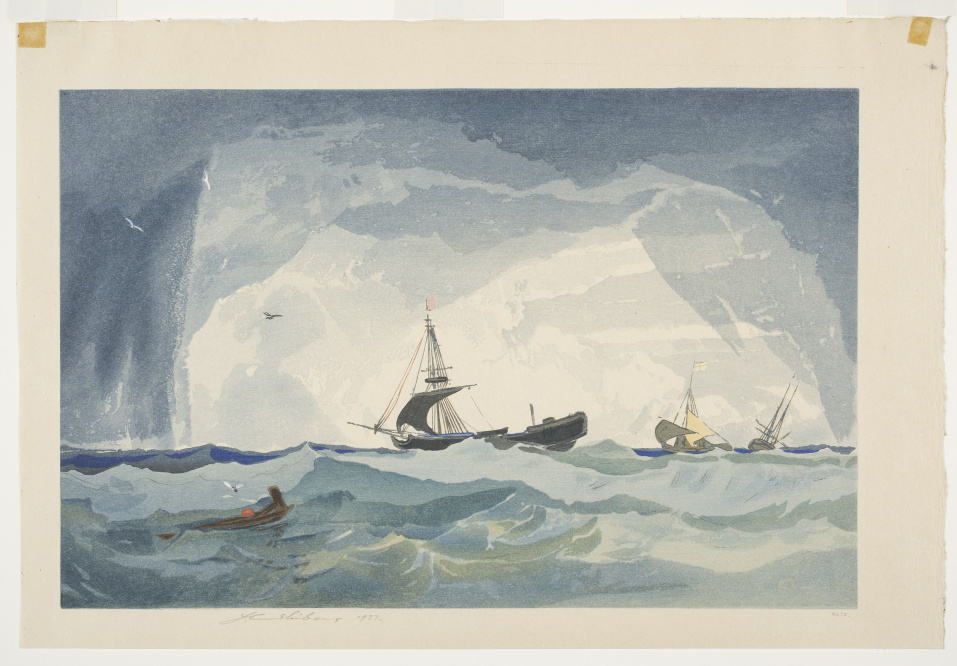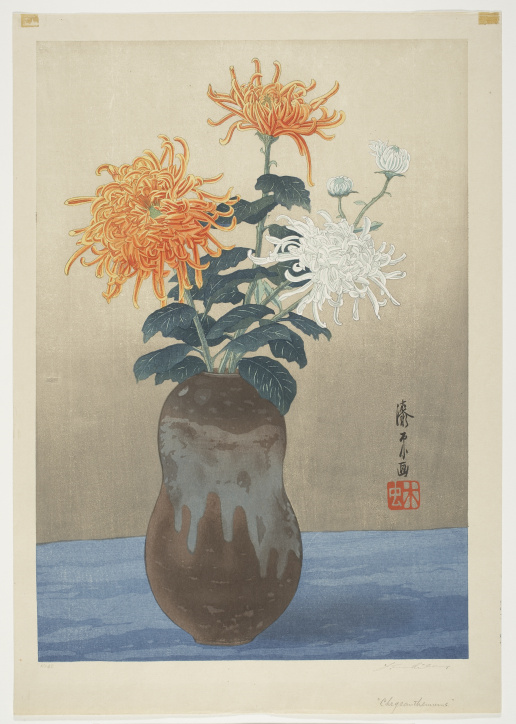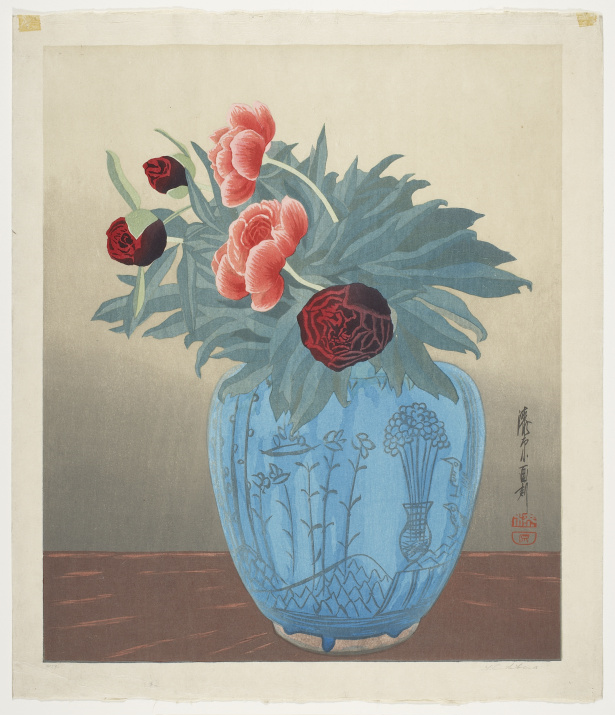In honour of Asian Heritage Month, we’re celebrating the work of an incredible Japanese artist. Yoshijiro Urushibara was an internationally acclaimed printmaker, and he had a very special relationship with Canadian artist Walter J. Phillips.
Lobster is an image of contrasts: an intense range of corals captures the light shimmering and glistening along the eponymous creature’s back, while deep, fine black lines convey the rough textures of the mussels surrounding it. It is a print that reveals Yoshijiro Urushibara’s virtuosic work in colour woodcut, a centuries-old practice that he reinvented for a modern audience. To create the work, he had to carve the image into blocks of wood, almost as if creating giant stamps filled with delicately carved lines, from the ridges in the mussels’ shells to the graceful arcs of the lobster’s claws. Every colour in the image had to be carved from a different block, and each time he printed a new block on the paper, it had to align perfectly with the previous block’s printing. Gradually, as each block was applied, the pigments merged perfectly into a single picture. It is one defined by a dramatic tension between colours and a perfect synchronicity in process, a combination that few artists ever achieve but one Urushibara attained in dozens of prints over the course of his career.
Born in Tokyo in 1889, Urushibara came from a family of artists and craftsmen. He began studying the art of woodcut at a very young age, and when he was twenty-one he was chosen to be one of a group of artists who travelled to London for the Japan-British Exhibition, which was held from May 14 to October 29, 1910.[1] One of several international exhibitions in London in the early 1900s, the event was intended as a grand public spectacle to strengthen ties—especially trade relationships—between the two countries. The highlight was an unprecedented display of Japanese art that included paintings, sculptures, architectural models, metal works, lacquered objects, and textiles.[2] Urushibara’s group was at the exhibition to demonstrate woodcut printing; although woodcut was not a highly prestigious artform in Japan, Japanese woodcut prints had been tremendously popular in Europe ever since the United States forced Japan to open its ports and markets to trade.
When the Japan-British Exhibition closed, Urushibara decided to stay in London. He began working for the British Museum, where he made reproductions and contributed to restorations of Asian paintings and prints. He also started collaborating with local artists, several of whom were fascinated by the possibilities of working in colour woodcut. Historically, many British artists had considered colour woodcut as a technique that was suitable for reproducing other artworks—but not necessarily a technique that was appropriate for creating original artworks. Urushibara demonstrated it could be both, and reproductive and original woodcuts could be equally extraordinary. He was uniquely able to do this. Although traditionally woodcuts were created by three different people—one person to draw the image, another to carve the blocks, and a third to undertake the printing—Urushibara did every element himself.
The print Sailing Ships at Sea is an outstanding example of how Urushibara approached reproduction. The work is based on a watercolour by John Sell Cotman from the British Museum’s collection; Urushibara likely saw the painting in a 1934 exhibition of English art. His print reproduces the translucent shades of blue that form the sea and sky with exceptional precision and delicacy, an achievement that received high praise when he exhibited it in 1937. A catalogue published by the Society of Graver Printers in Colour declared that it was an “excellent example” of woodcut as “an interpretive medium for expressing the qualities of the original masterpiece, and demonstrating the superiority of artistic hand work over photo-mechanical process reproductions.”[3] In praising Urushibara, this writer was very conscious of how difficult it was for photographs to capture the subtlety and intensities of colourful artworks accurately—unlike photographers at the time, Urushibara could achieve outstanding results. In addition to working on historic artworks, he also formed partnerships with contemporary artists who wanted to make their own prints. Around 1917, he started working with the British artist Frank Brangwyn, and the two ultimately made more than fifty prints together.
In the 1920s and 1930s, Urushibara published prints featuring his own compositions. He was particularly known for his floral still lifes filled with velvety blossoms and foliage, as can be seen in the prints Chrysanthemums and Flowers in Vase. His depictions of animals included birds, insects, and horses as well as sea creatures, and he imbued these subjects with movement and expression. He also created a small number of European landscapes, most notably Baie d’Eze, A.M., a dramatic view of cliffs along the French coastline. He exhibited his work regularly in London, and it attracted significant critical praise: in 1923, a critic described him as both “a masterly interpreter” of paintings and drawings and “a sensitive artist, expressing a pictorial vision of his own.”[4]
The Urushibara Collection at Glenbow comes from the collections of Walter J. Phillips, an artist who was born in Britain but immigrated to Canada in 1913. Phillips was fascinated by the Japanese colour woodcut technique and began experimenting with it in 1917, but he failed to truly understand the process until he met Urushibara on a trip to London in 1924. Urushibara taught him to prepare paper for printing such that it would capture unusual colour effects and he advised him on how to work with multiple wood blocks most effectively. Phillips went on to make the most ambitious prints of his career. He had a deep respect for Urushibara’s abilities, and in his book on woodcut he claimed, “Urushibara has never been surpassed from the point of view of technique […] in addition to his reproductive work he is responsible for some of the most interesting original prints of recent years.”[5] Phillips collected Urushibara’s work, and the two artists corresponded for years after their meeting in London—Venice in Winter is actually a Christmas card Urushibara sent to Phillips. They lost touch only after Urushibara and his family returned to Japan in 1940 in the midst of the Second World War. Urushibara died in 1953, and in 1961 Phillips sold his collection to the Glenbow Foundation.
References
[1] Libby Horner, “A Biography of Yoshijiro Urushibara,” in Yoshijiro Urushibara: A Japanese Printmaker in London (Leiden: Hotei Publishing, 2017), 10.
[2] Meri Arichi, “Treasures of the Nation: Japanese Paintings in the Fine Arts Palace,” in Commerce and Culture at the 1910 Japan-British Exhibition: Centenary Perspectives, eds Ayako Hotta-Lister and Ian Nish (Brill, 2013), 142.
[3] Yoshijiro Urushibara: A Japanese Printmaker in London, 165.
[4] Malcolm C. Salaman, “Mr. Urushibara’s Wood-Block Colour-Prints,” Studio: International Art 86, no. 368 (November 1923): 258. https://doi.org/10.11588/diglit.21398.47.
[5] Walter J. Phillips, The Technique of the Color Wood-cut (Brown-Robertson Co., 1926), 22.






